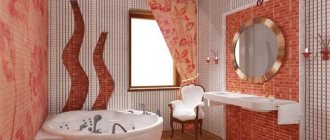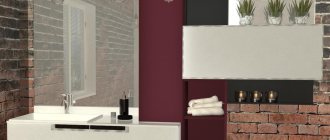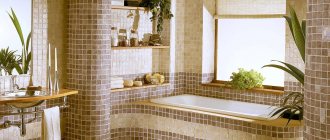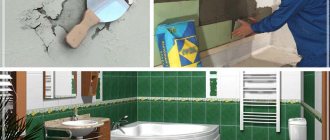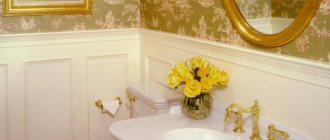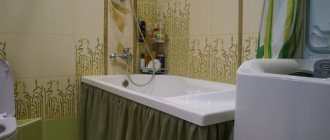A bathroom is a mandatory attribute of most modern apartments and many private houses. In some places it is very spacious and wide, so there are no problems with the placement of plumbing fixtures and household appliances. But most often there is not much space - then the issue of a clear layout is most relevant. In both cases, the scope of design ideas is limitless. A bathroom elongated in the shape of a rectangle is quite common, and so is its beautiful, harmonious arrangement. How to choose the best design for a narrow bathroom, carefully fit everything you need into a given room, maximize the space, see details in the text of this article.
Layout features
A narrow bathroom is most often found in those buildings where it was not originally intended, “Stalin buildings”. These interiors are usually designed in loft, urban, and industrial styles. For small apartments, such a combined bathroom is more the rule than the exception. The bathroom needs to be arranged so that it is convenient to use, everything you need is placed compactly, and there is room for free movement.
How to plan a narrow bathroom space:
- use clear geometric shapes to the maximum;
- do not use a large number of colors at the same time;
- maintain a balance of horizontal and vertical lines;
- decor, dark colors - minimum quantity;
- the harmony of the proportions of all objects is also important;
- use various techniques to expand space.
It is better to place storage spaces vertically, keep all detergents in closed cabinets, or purchase compact one-color dispensers.
Choosing a finish for a narrow bathroom
When choosing a color scheme in the design of a narrow bathroom, the main thing is not to forget one rule: dark colors should be at the bottom, and light colors at the top.
The easiest and most affordable finishing option would be laying ceramic tiles. For a small room, you should choose tiles that are not very dark, but preferably lighter, spring tones.
Less aggressive, red shades. Dark shades are acceptable in small elements and patterns.
If the decision is made in favor of painting the walls, then to visually expand the bathroom, you can use narrow horizontal stripes.
Small decorative elements on the walls in the form of a mosaic will also help expand the space. In the modern design of narrow bathrooms, photo printing is popular.
The drawings depicted on it, which lead the eye into the distance, are an excellent option for narrow rooms. The most advantageous colors will be blue and light gray. You should not choose dark or bright shades.
For the floor, you can choose tiles with geometric patterns. A triangular ornament will visually lengthen the floor, the wide side of which will be at the entrance, and the corner closer to the wall.
Square and rectangular patterns on the floor will help expand the space. Floor tiles should be laid diagonally.
To finish the ceiling of a narrow bathroom, you can use plastic or plasterboard panels laid transversely to the entrance.
A good solution for the bathroom would be moisture-resistant liquid wallpaper. With their help you can also expand the space if the structure of the wallpaper is not large.
Selection of finishing materials
The humidity in the bathroom is always high, so moisture-resistant materials are selected:
- stone – artificial, natural;
- ceramic tile;
- linoleum;
- glass, mirrors;
- drywall;
- self-adhesive films;
- waterproof “liquid wallpaper”.
Floor design in limited space greatly influences the overall appearance of the entire room. A plain glossy self-leveling floor, especially if translucent, adds volume to the room from below. To avoid a “corridor effect”, the space is divided into two, three or four separate zones: near the sink, toilet, bidet, bathtub. It is preferably four-six-octagonal.
To expand the space, tiles are laid diagonally; floor tiles are preferably many times larger than wall tiles. Triangular, located with the wide side towards the entrance, visually lengthens the floor. With the help of different textures, colors, and wall designs, the space is also zoned. Wall panels made of plastic, “flexible stone”, paint, glazed ceramics, large mirrors, and horizontal borders will be used. Vinyl photo wallpapers with sea, natural views, and fantasy designs also look great.
The ideal design for a bathroom ceiling is PVC stretch films. Glossy or matte, with sparkles or an image of the sun, cosmic starry sky. Properly selected lighting will allow you to imitate a real window in the ceiling.
For furniture finishing, plastic, special laminated MDF, and glass are preferred. Waterproof wallpaper is chosen with a small pattern, depending on the stylistic design of the room.
Turnkey renovation of a small bathroom
As you can see, a small bathroom is not a disaster at all. With a well-thought-out design, you can create a beautiful and modern interior. By entrusting the renovation to professionals, you will receive an elegant, cozy room in which it will be pleasant to carry out hygiene procedures, relax and unwind after a busy day at work.
| Types of jobs | Quantity |
| Demolition of aceid or gypsum sanitary cabin (walls and ceiling) and construction of new walls | |
| Dismantling work (dismantling old plumbing, tiles, doors, etc...) | |
| Primer of walls and floors (two layers) | |
| Leveling walls and floors according to beacons | |
| Installation of coarse filters, meters, fine filters, collectors (combs) for cold water and hot water supply | |
| Installation of water pipes and sewerage (with recessing into walls) | |
| Installation of a plumbing duct in the toilet (from foam blocks) | |
| Waterproofing in the bathroom | |
| Installation and connection of a cast iron bath | |
| Fan installation | |
| Electrical installation work (sockets, replacement of electrical wiring, switches, installation of lamps) | |
| Installation of heated floors under tiles | |
| Laying tiles or mosaics on walls and floors | |
| Grouting joints | |
| Installation of slatted, plastic ceiling or stretch ceiling | |
| Installing roller shutters or an invisible hatch in a sanitary closet | |
| Installation of an overhead screen under the bathtub (MDF or PVC) | |
| Installation and connection of any types of bathtubs, shower enclosures, sinks with cabinets, floor-mounted or wall-hung toilets with installation, washing machines, sink and bathtub faucets, shower systems | |
| Installation and connection of a water and electric heated towel rail | |
| Door installation | |
| Installation of accessories | |
| Cleaning and removing trash up to the stairwell |
For more than 10 years, we have been renovating turnkey bathrooms and sanitary facilities in Moscow. Labor warranty 3 years. We work without prepayment! Call us, we will be happy to make your dreams come true!
Order a bathroom renovation etc.
Choice of colors
Snow-white or bluish plumbing fixtures will fit perfectly into any bathroom - large or small, wide or narrow.
In an elongated bathroom it is preferable to:
- dark below, light above;
- bright, aggressive colors - minimum;
- average horizontal strip width;
- photo wallpapers and colored mosaics significantly expand the space;
- light, delicate, pastel colors.
The best colors are gray-blue, beige-yellow, light violet, pale fuchsia, soft ocher, various shades of blue, pink, light green, etc. If there is a window and sunlight actively penetrates it, then for the “northern” It is better to choose warm, bright shades for rooms; modest cool colors are more suitable for “southern” rooms. When contrasts cannot be avoided, experts recommend using one main color, adding a maximum of two other colors to it. The classic white and black color scheme, golden blue, green and brown looks good.
Not all people support the “fashion” for a particular style, so you should be guided by your own ideas in your color choice.
Lighting
Proper lighting significantly affects the overall appearance of the room; it is preferably bright and abundant. If the lighting is a single lamp with one bulb on the ceiling, as in all “Stalin” buildings, then such a space does not look the best. It’s a little dark in all the corners, and the room resembles an elongated corridor. Spot lighting around the perimeter, local lighting above each plumbing fixture, mounted rotating mini-spotlights, and various sconces will be the best solution. The LED strip, which is hidden behind the cornice, creates the impression of a “flying ceiling” and high walls. Illumination of individual functional areas divides the space into “logical squares”. Additional light, the sources of which are located under the bathroom, along its perimeter, under the plane of the self-leveling transparent floor, also looks excellent. Lighting around the mirror is convenient if makeup is supposed to be applied in this room.
When installing a “luminous” floor, waterproofing is important - moisture should under no circumstances interact with wires or any electrical appliances. Sockets are selected that are safe - with covers.
Selection of furnishings and storage systems
When there is enough space, a shelving unit or floor cabinet is placed in the room. A chest of drawers is placed under the sink, preferably with a rotating shelf design. All angles should also be used as much as possible. Compact storage spaces are provided under and above the bathtub. A complete set of furniture can be purchased immediately - this is offered by most companies that deal with the design of baths and toilets. If there is very little space, which often happens when improving bathrooms in buildings that were once non-residential, then it is better to order all the furniture according to individual sketches. An elongated heated towel rail complements the interior in an original way; it should fit well into the design of the room.
Manufacturing materials are selected intended for rooms with high humidity.
Selection of plumbing
When there is very little space, you should prefer the most compact models.
Most suitable for a narrow room:
- corner sink;
- wall-hung washbasin;
- shortened bathtub, shower stall;
- toilet with hidden cistern, bidet.
A bidet will be placed next to the toilet - if possible, then they are placed side by side, along a short wall, and opposite - a corner or short bathtub or shower stall. The sink can be placed in a very miniature size - if it is wall-hung, then you should consider the option of placing it above the washing machine or cabinet. Depending on the size, the shower stall occupies the entire narrow wall or part of it. If the width is two meters or more, then the furniture is placed differently - the bathtub itself is placed along one long wall, along the other - all other appliances - toilet, bidet, sink, washing machine, etc.
The place where they take a shower is sometimes not designed as a cubicle, but is simply separated by a glass partition. In this case, it is important to properly organize the drainage so that puddles do not form in the room.
How to arrange a bathroom?
When planning a non-standard room, we recommend starting with creating a plan for a narrow room. The drawing will help you decide on the placement of plumbing fixtures and furniture and understand whether there is enough space for everything you need.
We select compact and functional furniture
The design of a narrow bathroom depends on the dimensions of the room.
- Large rectangular. The spacious bathroom has enough space for floor cabinets and spacious pencil cases. Do not install furniture in 2 rows on long sides, leaving a narrow passage. The most advantageous layout option is a corner one.
- Small narrow. When there is not enough space for a storage area, use every centimeter of space. Organize storage under the bathtub and sink using special fittings. Install racks or shelves above the toilet if you have a combined bathroom. Make use of space in corners.
The photo shows a large cabinet under the sink
There is no need to build a washing machine into the bathroom, but it is good to provide a convenient place for baskets with dirty laundry. Install them under a wall-mounted sink or hide them in one of the furniture modules - all the necessary accessories can also be found in a specialized store.
What sanitary ware is suitable for a narrow bathroom?
First, decide on the largest item in the room—will you have a narrow bathroom with a bowl bath or a walk-in shower? If width allows, the selected option is installed along the far narrow wall. The second way is to install a bowl or stall in a corner, leaving space on the side for a sink or toilet. For a large narrow bathroom, it is possible to install a corner shape.
When buying a washbasin, also consider the possibility of saving space: models with a pedestal use space inefficiently. You can improve situations by building a sink into a cabinet, hanging it above furniture or a washing machine.
As for the toilet, consider modern models with a hidden tank. Or, as we already said, install a shelving unit behind the classic variation.
An optional element of the bathroom is a bidet. The most advantageous location for it is next to the toilet.
Using mirrors for visual expansion
Large mirrors can visually expand the space of any room. In a narrow bathroom, it is preferable to install them on a long wall to make the room seem wider. Located on a smaller wall, they visually stretch, narrow, and lengthen the room, which does not look very nice. When there are several mirrors, one of them is purchased as a “make-up” mirror - it has lighting around the perimeter. A mirrored ceiling and the same mosaic on the walls, furniture, and floor will perfectly decorate the room.
The presence of a window should not be perceived as a disadvantage - it perfectly expands the space of a cramped room, and to maintain privacy it is decorated with glass with one-way visibility and colored stained glass.
The main mistakes when renovating a narrow bathroom
The location of the toilet opposite or in close proximity to the door
The standard plan dimensions of a toilet are 35-40 cm (width) by 60-70 cm (depth). Let’s say the width of our bathroom is 1.5 m. It turns out that the toilet covers almost half of the room. By placing the toilet at the entrance, we automatically reduce the width of the passage to the washbasin and bathtub or shower. When placing the toilet, you should also be guided by the consideration that the toilet is not the most frequently used item in the bathroom. For example, we use the washbasin much more often. In addition, the depth or reach of the washbasin is usually 40-50 cm. And this is 1.5 times less than that of the toilet. Therefore, it will be more convenient to enter and exit the bathroom. From this we conclude that the washbasin should be located opposite or first from the door in a narrow bathroom.
Placing a bathtub or shower along the long side of a narrow bathroom.
The consequences of such placement of a bath or shower are obvious. We will narrow the room even more and make it difficult to access other bathroom equipment, and even to the bathtub or shower stall itself. To prevent this from happening, the bathtub or shower stall should be placed on the short side, away from the door. As a rule, they occupy a place between two long walls, at the end of the room. The distance from the door is also justified by the fact that we use the bathtub or shower less often than the washbasin and toilet, only 1-2 times a day. Thus, having avoided these two mistakes and correctly positioned the washbasin and bathtub or shower, all that remains is to position the toilet. The only place for it is the space between the bathtub and washbasin. For a more comfortable passage to the bathtub, it is desirable that the depth or overhang of the toilet bowl be minimal.


